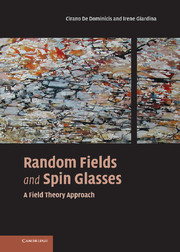Book contents
- Frontmatter
- Contents
- Preface
- List of abbreviations
- 1 A brief introduction
- 2 The Random Field Ising Model
- 3 The dynamical approach
- 4 The p = 2 spherical model
- 5 Mean field spin glasses: one-step RSB
- 6 The Sherrington–Kirkpatrick Model
- 7 Mean field via TAP equations
- 8 Spin glass above D = 6
- 9 Propagators, mostly replicon
- 10 Ward–Takahashi Identities and Goldstone modes
- 11 Alternative approaches and conclusions
- Appendix A Renormalization at one loop: ϕ4 theory (pure Ising)
- Appendix B Renormalization at one loop: tr ϕ3 theory (spin glass)
- Index
Preface
Published online by Cambridge University Press: 21 October 2009
- Frontmatter
- Contents
- Preface
- List of abbreviations
- 1 A brief introduction
- 2 The Random Field Ising Model
- 3 The dynamical approach
- 4 The p = 2 spherical model
- 5 Mean field spin glasses: one-step RSB
- 6 The Sherrington–Kirkpatrick Model
- 7 Mean field via TAP equations
- 8 Spin glass above D = 6
- 9 Propagators, mostly replicon
- 10 Ward–Takahashi Identities and Goldstone modes
- 11 Alternative approaches and conclusions
- Appendix A Renormalization at one loop: ϕ4 theory (pure Ising)
- Appendix B Renormalization at one loop: tr ϕ3 theory (spin glass)
- Index
Summary
I vividly remember the academic year 1977–1978. I was a Loeb lecturer at Harvard that year. The Wilsonian revolution had been blossoming everywhere and I was teaching ‘field theory approach to critical phenomena’ in the wake of the works of my colleagues and friends Edouard Brezin and Jean Zinn Justin. I had not yet been exposed to the novel intricacies that were being uncovered in the critical behaviour of quenched random systems. But, during that year, several seminars were to deal with them and I began learning and interacting with Mike Stephen, Jo Rudnick and the late Sheng Ma. This is how it all started for me. A good quarter of a century later, the two central problematic systems of the field, the Random Field Ising Model and the Ising Spin Glass, despite several thousand papers and a huge amount of efforts dedicated to them, remain objects of controversy for what concerns how to describe their glassy phase. So why add a book on top of that? Perhaps I will tell how it all occurred.
At the origin the book was a mere set of lecture notes for a course given in this laboratory, a course that was largely repeated two years ago in the theory group of the physics department at UFRS in Porto Alegre. The Lecture Notes Series of Cambridge University Press having been discontinued, it was gracefully suggested that the notes be transformed into a book.
- Type
- Chapter
- Information
- Random Fields and Spin GlassesA Field Theory Approach, pp. xi - xivPublisher: Cambridge University PressPrint publication year: 2006

